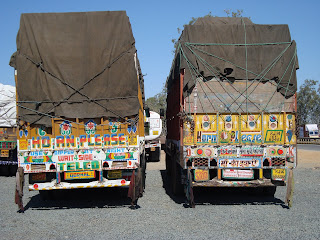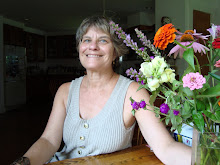

Since I wasn’t able to keep up with my blogging while on the road, now I’ll go back a week in my mind and try to recall all our adventures in Rajasthan. We left Anand last Friday morning for a week’s trip during mid-semester break. A car and driver from IRMA drove us to Udaipur (about 200 miles; a four hour trip) for the first leg; since this driver was a particularly aggressive honker and passer (which in India is really saying something!), Bob – in the front seat – had a white-knuckle ride, while I, comfortably fatalistic in the back, enjoyed the passing scene, both the crowded, trash-filled small towns and the intervening stretches of green countryside.
Udaipur, where we settled for the first four days, was a relaxing, quite lovely small city, made particularly enjoyable by the facts that 1) we lucked out with our hotel choice, the unusually pleasant Mahendra Prakash Hotel (more on this later); 2) the scale of the city and the location of our hotel meant that we could walk or take a short auto-rickshaw ride most everywhere we wanted to go, which made everything feel very manageable; and 3) since we knew Vidhi and Manish Jain (Vivek’s sister and brother-in-law) we were able to spend time with them and people they knew as well as on our own.
According to the guidebooks, Udaipur’s three biggest claims to fame are its very large lake (and chain of outlying lakes), which led Lonely Planet to label it “the Venice of India,” the extremely pricey luxury hotels that have been created out of old palaces on two islands in the lake, and the City Palace, an absurdly huge palace started by Maharaja Udai Singh II, the city’s founder, in approximately 1560 and added onto by numerous other maharajas over the decades, which is now a historical monument with museum. All of these things had their charm, but also their limitations, so my favorites were different. The lake, for example, while indeed lovely, especially when viewed from the heights of the City Palace grounds or at sunset, when the light sparkles on the water, flocks of birds are silhouetted against the sky, and the mountains rise mistily in the distance, was also pretty swampy and covered with unattractive patches of green goo when seen close up, since several years of drought had evaporated a lot of it – hardly Venice material. The City Palace has beautiful grounds overlooking the lake in which to walk (and, at Rs. 25 admission, are a bargain pleasure), but the palace itself is SO big and confusing to walk through that it is more like a feat of endurance than a total treat. I haven’t visited palaces in Europe, which may be the same, but most of the palaces I’ve seen here so far strike me more as something to marvel at rather than something to enjoy – and I haven’t found them at all tempting, even in fantasy, as places to live.
Mostly I find myself thinking about how many people must have worked themselves to the bone to build the place and how many more would be necessary to make living there on a day-to-day basis even vaguely bearable in the days before electricity, not to mention plumbing – just to light the candles necessary to bring some light into the gloom after sunset must have taken a staff of dozens! I’d never thought much about Indian royalty before this trip, but now I feel clearly it wasn’t only the British who oppressed the Indians – whatever the British sins (and I’m not denying they were many), the indigenous ruling class, with its maharajas, nawabs, and maharanis, certainly did a good job of standing on people’s necks itself.
So my favorite things about Udaipur were 1) the Jagdish temple, a magnificent carved Hindu temple built by Maharaja Jagat Singh in 1651 that was right in the center of town up a long flight of stairs from the street, 2) just walking around the streets filled with endless stalls of fabric, clothing, jewelry, leatherwork, miniature paintings, vegetables, block after block after block of crowded, lively, colorful, intriguing markets, 3) our hotel and the huge public park and garden across the street from it, and 4) meeting the painter Shahid Parvez, a friend of Vivek’s sister and brother-in-law (Vidhi and Manish Jain) who live in Udaipur, who shows his work at his own gallery, the Gallery Pristine, on one of the downtown streets. I think I’ll pause now and post this much; I’ll save for later why these were my favorites, and the rest of the stories about our trip.






3 comments:
Interesting that you and Bob reacted the same to the Indian driving scene as we did. For the first few weeks, Peter was saying "Oh my God! Did you see that? Watch out! What does he think he's doing!?" much to the amusement of our Indian friends who said it's a common reaction of Westerners. I decided immediately we were either going to die or we weren't, so I just got interested in trying to figure out the unwritten rules of the road of which they are many and reveal a lot about the spiritual nature of this country. A taxi driver told us that to be a good driver in India requires five things: good brakes, a good horn, good eyes, a peaceful nature, and luck.
Have enjoyed Flat Jonah and your more recent posts. I am without access to writing email -- my Comcast saga continues, and now I can't reply or initiate messages from that accounts. And so, rather than resort to my gmail account, I'll just jot a quick note here to say that I'll try to Skype you on Monday morning (Presidents Day here), assuming that Skype is not affected by Comcast woes. (Skype operates independently of Comcast, so that shouldn't be a problem, but as I'm in a little cornere of techno-hell these days, I'm not feeling very optimistic about technology in general.) I'll call using Penny Talk, otherwise. Sending love and beleated Valentine wishes. I loved your photo from Nawalgarh; it's up above my desk.
Love, Ruth
You recent trip sounds like a much more enjoyable adventure than your posting in Anand. We're due for more snow in New England this week, so don't rush to get home. I love your postings. Oh ... don't get killed before you come home. Might want to put Bob in the back seat from now on.
Post a Comment